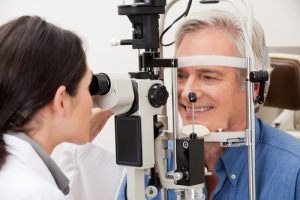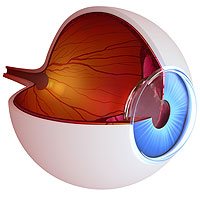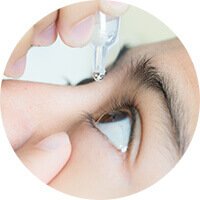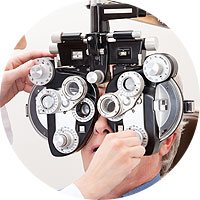Glaucoma is one of the most common eye conditions and is also known as the “silent thief of sight.” Glaucoma can seriously damage your vision without causing many noticeable symptoms.
It can affect people of all ages and backgrounds. However, some people have a heightened risk.
Keep reading to learn more about glaucoma, including who is most at risk for developing it!
What Is Glaucoma?
Glaucoma is typically caused by higher-than-normal eye pressure, also known as intraocular pressure. When your eye pressure is elevated for an extended length of time, it can cause damage to the optic nerve.

The optic nerve is a bundle of fibers located at the back of the eye. It relays visual information to the brain.
Damage to the optic nerve is what causes vision loss in glaucoma. The extent of vision loss depends on how long intraocular pressure remains raised and how high the eye pressure is.
Glaucoma is not a singular eye condition. The name actually refers to a group of eye conditions.
There are a few different types of glaucoma. The most common one is open-angle glaucoma.
With this type of glaucoma, pressure builds up over time, eventually damaging the optic nerve. In some cases, individuals can still be diagnosed with glaucoma without having elevated eye pressure.
What Are the Most Common Symptoms of Glaucoma?
The early stages of open-angle glaucoma do not present with many symptoms, so you may have glaucoma without even knowing it. This is why regular eye exams are so important.

During regular, routine eye exams, your eye doctor will be able to identify early signs of many eye conditions, including glaucoma, to help prevent vision loss. For example, tonometry is a test that measures eye pressure and is performed during every routine eye exam.
Most people with glaucoma will start to experience more and more peripheral vision loss as time goes on. Vision loss usually happens slowly, but if left untreated, it eventually affects the central vision.
If left untreated, glaucoma can lead to significant vision loss and even total blindness. Damage to the optic nerve cannot be reversed, so any vision lost from glaucoma is permanent.
Although rare, one type of glaucoma involves the sudden onset of symptoms. This type is called angle-closure glaucoma.
Instead of damage occurring gradually, fluids in the eye build up rapidly and cause an immediate spike in eye pressure. In addition to blurry vision, this can cause symptoms like severe eye pain and nausea.
What Causes Glaucoma?
In most cases, it is unknown what exactly causes eye pressure to become elevated. Your eyes are constantly creating and recycling fluid.
In order for the pressure in your eyes to maintain at a healthy level, fluid needs to leave the eye consistently. Sometimes, the fluid in your eye do not drain properly, and the build-up of fluid is what leads to increased pressure.
Other times, there may be a blockage that prevents fluid from draining as it should. In some cases, babies are born with glaucoma.
This is called congenital glaucoma. Congenital glaucoma is typically the result of a developmental abnormality that affects the eye’s drainage system.
Who Can Develop Glaucoma?
Unfortunately, it is not possible to prevent glaucoma. Glaucoma can affect anyone, regardless of age.
However, some risk factors can make you more likely to develop glaucoma. First, while a person of any age can develop glaucoma, it is more common in those who are forty and older.

There are a few reasons why this is true. Over time, age-related changes can affect the performance of the optic nerve and the drainage network.
Family history is another factor that can increase your risk of developing glaucoma. If other people in your family have been diagnosed with glaucoma, it is more likely that you will develop the eye condition as well.
Injuries to the eye can also lead to the development of glaucoma. They can cause eye pressure to increase, especially if the drainage network is damaged.
When it scars over, it can make it hard for fluid to pass through. If you have a higher risk of developing glaucoma, it’s recommended that you have your eyes examined more frequently.
How Is Glaucoma Treated?
Glaucoma is treatable, but there is no cure. Glaucoma treatment aims to lower eye pressure and prevent the condition from causing any further vision damage.
The earlier glaucoma can be diagnosed, the better your chance of preserving your vision. Regular eye exams are essential for early detection and treatment of glaucoma.

There are several effective treatments for glaucoma available. The best choice for each person will depend on their individual circumstances, including the type of glaucoma they have.
In most cases, prescription eye drops are the first course of treatment. They can help lower eye pressure.
When eye drops do not provide the desired effect, glaucoma surgery may be recommended. Laser surgery and microsurgery can allow for greater outflow of fluid, thus reducing eye pressure.
Are you experiencing symptoms of glaucoma or have a family history of the condition? Schedule an appointment at Eye Care Specialists in Wilkes-Barre, PA, today!

















